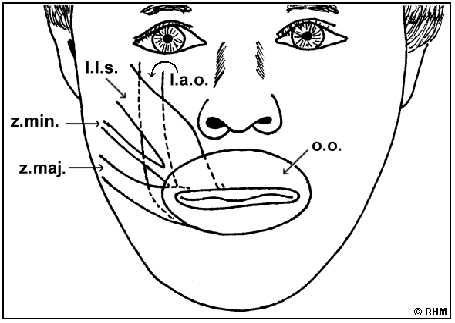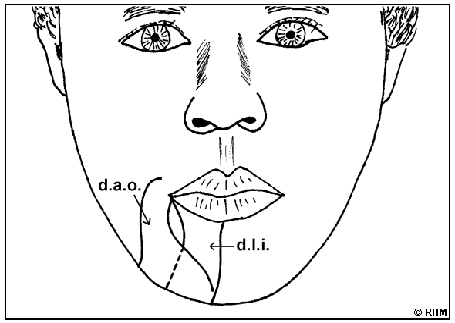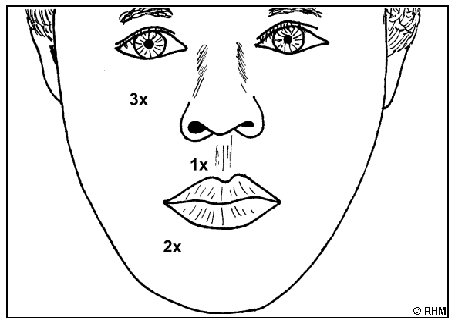EMG review
Overview of EMG methodology
a. The results most valuable to the purposes of phonetic research have been obtained in this field with the use of needle electrodes. At present the Speech Hearing and Language Research Centre (SHLRC) is not equipped with this form of electromyography. In any case, there is good reason that it should only be undertaken under medical supervision. For this reason this experiment deals only with surface electrodes.
b. Small electrodes are used which are attached to the skin by specially designed circles of plastic, the unreasonable expense of which limits the number which can be used by any one student group. Before attaching each electrode a drop of electro- conductive jelly is placed on its centre so as to ensure optimum electrical contact between the electrode and the skin. The jelly permeates the skin to some slight extent.
c. There is one common earth electrode which is to be attached at any convenient point on the body adjacent to the area being investigated and there are two electrodes for each putative muscle being investigated. It will be appreciated that the limitation of surface electrodes lies principally in the fact that it is difficult to know if the electrode is placed over the correct muscle and impossible to know if it is picking up signals only from that particular muscle, and not from those adjacent to it.
d. In any one speech act many muscles are involved. Presumably the more muscles sensed simultaneously the more complete the picture of what is going on becomes. We are limited to studying only three muscles at a time since the computer interface is presently limited to only three EMG channels. In addition to those three EMG channels we will also have a speech channel in order to allow us to correctly relate muscle activity to the sound with which it is associated.
e. The electrical signals (ie. voltages) which come onto the electrodes are passed to biological amplifiers which magnify them and pass them to the computer.
Biological amplifiers are much like any other amplifiers except that they have very low inherent noise of their own. The ones used in this experiment have:
- an audio output so that the signals passing through may be listened to if desired, by plugging in earphones or a loudspeaker;
- a gain switch which controls the degree of amplification;
- an integrator which provides an output proportional to EMG signal energy.
The voltages which come into the amplifiers and are magnified may have a number of sources. They may, for instance, be induced in the wiring from the electrodes by the activity of nearby fluorescent lighting or nearby electronic equipment. Ideally, therefore, EMG studies are carried out in specially constructed rooms or earthed wire-mesh cages. To minimise the interference which induced signals cause, two electrodes are placed on each muscle. The signals coming from them are put 180 degrees out of phase by the biological amplifier in question and hence common signals, such as those induced by nearby electrical circuits, are eliminated or at least reduced. It is really the difference between disparate signals which is amplified. Hopefully, therefore, it is the muscle activity, which induces random depolarisations of contracting muscle fibres, which is principally displayed by the variations written on the computer, and which the system adds and displays as a single line.
f. The muscles of the speech mechanism which are most conveniently sensed by surface electrodes are those which control lip activity.
These include:
- orbicularis oris - closes lips, protrudes lips (by differential activity), presses lips against teeth
- levator labii superioris - running from the lower margin of the eye-hole to the corner of the mouth - raises and turns out the upper lip
- levator anguli oris - running from maxilla to the corner of the mouth - raises the corner of the lips towards the naso-labial furrow
- zygomaticus major and minor - running from the zygomatic bone to the corner of the mouth - pulls the corner up and out (smile)
- depressor labii inferioris - running from the mandible to the lower lip - pulls lip down and a little out
- depressor anguli oris (triangularis) - running from the mandible to the corner of the mouth - pulls the corner down and very slightly out
There are other muscles, of course, like the buccinator, mentalis, caninus, risorius etc. of which an ideal study would no doubt take account.

Figure 1: Some facial muscles. zigomaticus major (z.maj.), zigomaticus minor (z.min.), levator labii superioris (l.l.s), levator anguli oris (l.a.o.) and orbicularis oris (o.o.)

Figure 2: Some facial muscles. depressor anguli oris (d.a.o.) and depressor labii inferioris (d.l.i.)

Figure 3: The positions of the three pairs of electrodes used in this study. 1. orbicularis oris, 2. depressor labii inferioris, 3. levator anguli oris
g. Viewed phonetically it seems from earlier studies that the following activities of the lips may be related to the muscles indicated.
- lip rounding: orbicularis oris, buccinator, depressor anguli oris, mentalis (eg. /ʉ o y/)
- lip spreading: levator anguli oris, risorius, buccinator, depressor anguli oris (eg /i e ɛ/)
- oral stop closure: orbicularis oris, mentalis, depressor anguli oris + inhibition of the levator labii superioris, depressor labii inferioris (eg. /p b/)
h. It would seem best, when only three EMG signals can be dealt with, to affix our electrodes so as to pick up the orbicularis oris (1), the depressor labii inferioris (2), and the levator anguli oris (3)
One may be reasonably optimistic that positions (1) and (2) will return the activity expected of them but position (3) is less clear in as much as signals from both the levator labii superioris and the levator anguli oris may be picked up at the same time. Placement closer to the orbit might seem to be suggested but there are other muscles there and it may be best just to accept this as a limitation which cannot be avoided without the recourse to needle electrodes. We may refer to signals from position (3) as referring to the somewhat spurious levator group. In practice, position (2) could well pick up both depressor muscles and so this position will be considered to refer to the depressor group.
i. Before attaching the electrodes to the subject, swab the skin with alcohol and allow to dry. Fit each electrode to its plastic circle and apply a drop of conductive jelly. Meanwhile the subject can assist by moving the lips from spread to round while feeling the chin area in order to locate the depressor anguli oris and indicating a suitable place to apply the electrodes of position (2). Position (1) offers no difficulty and position (2) little, but position (3) can be troublesome and may require a little trial and error. The subject can assist by grimacing and smiling and attempting to lift the upper lip. The fingers can pick up the activity of the "levator group" quite easily, the difficulty is in contracting it at will. It is usually best if the subject can indicate where the electrodes should go, but if this is not possible place them about 15 mm away from the nose and about 10 mm above the level of its maximum width. Attach all seven electrodes.
j. While the subject spreads, rounds and protrudes the lips randomly, adjust the biological amplifiers until an adequate signal is being received on all three EMG channels. If one is not adequate and cannot be rectified by adjusting the electronic equipment, it may be necessary to try relocating the electrode in question. Obviously, this should be avoided where possible.
Finally, adjust the gain of the microphone into which the subject will speak during the experiment so as to achieve a satisfactory waveform display on the computer.
k. The subject should now articulate the following series of sounds.
Note: Somewhat exaggerated lip movements will yield the "best" results (ie. greatest EMG response). Natural speech movements may not show anything. For present purposes it may be desirable to "overarticulate" a little but there should be no more overarticulation than is really necessary. Pause between each token to allow the muscles to reach a relaxed state before the next word otherwise the muscle movements will be continuous from one word to another.
- the lip-spread vowels /iː e/ uttered long
- the lip-rounded vowels /ʉː oː/ uttered long
- the lip-neutral vowels /ɐː ɔ/ uttered long
- the following nonsense sequences:
| /i:bi:/ | /i:pi:/ | ||||
| /ʉ:bʉ:/ | /ʉ:pʉ:/ | ||||
| [e:be:] | [e:pe:] | ||||
| [æ:bæ:] | [æ:pæ:] | ||||
| /ɐ:bɐ:/ | /ɐ:pɐ:/ | ||||
| /i:hi:/ | /ʉ:hʉ:/ | [e:he:] | [æ:hæ:] | /ɐ:hɐ:/ | |
| /i:hʉ:/ | /ʉ:hi:/ | /i:bʉ:/ | /ʉ:bi:/ | ||
| [y:hʉ:] | [ʉ:hy:] | [y:bʉ:] | [ʉ:by:] | ||
| /i:p/ | /i:b/ | /ɐ:p/ | /ɐ:b/ | ||
| /i:f/ | /i:v/ | /ɐ:f/ | /ɐ:v/ |
Content owner: Department of Linguistics Last updated: 12 Mar 2024 10:13am
